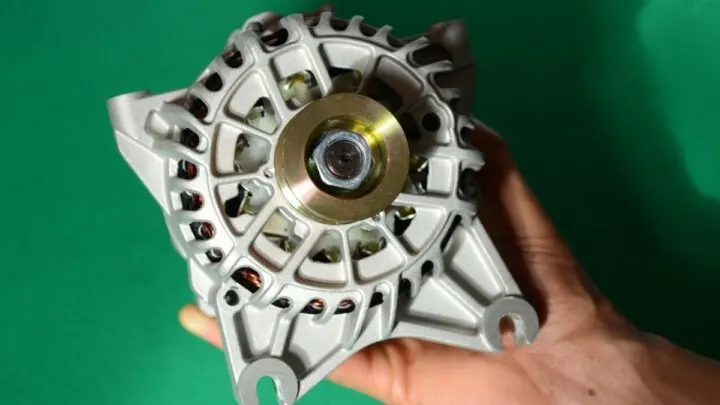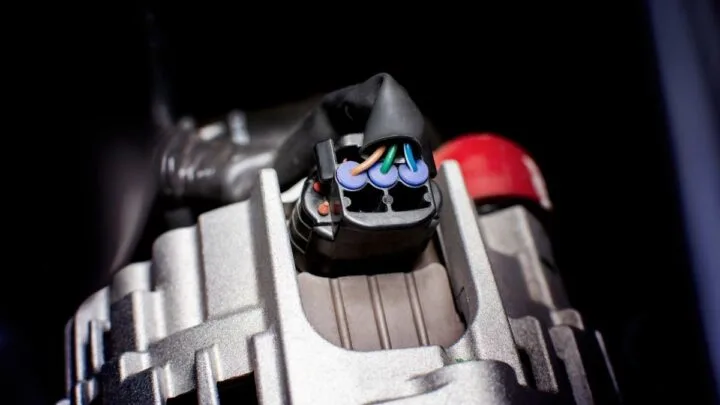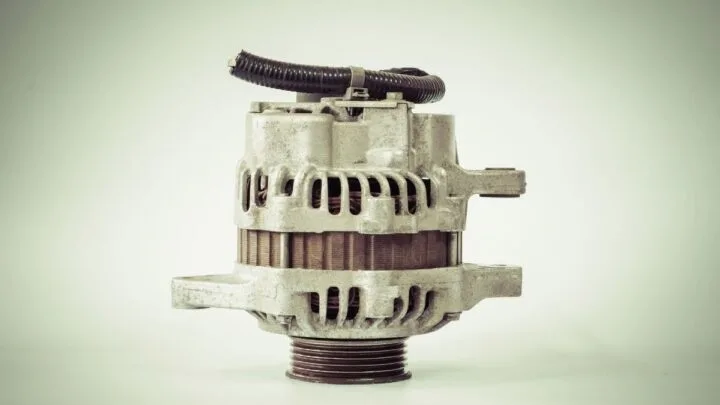It’s a common misconception that vehicles run exclusively on fuel and battery.
When we think of the music we hear, the dashboard lights, headlights, or even phone chargers, we mostly think of the battery.
However, the battery is only one small component of your vehicle’s electrical system.
A majority of the electricity we use in our vehicles comes from the alternator. Which means that it’s important to know when to replace your alternator and how long it could take.
Replacing your alternator often takes less than 2 hours if you know how to change it yourself. If you don’t have mechanical experience, it’s best to take it into a mechanic, where they can change it with relative ease if they aren’t busy.
In today’s article, we’ll look into the working of an alternator, how to tell if it’s bad, how to test it, how to replace one, and finally, the time it takes to replace one!
How Long Does It Take to Replace an Alternator?
Your vehicle has many electrical components that work in tandem to ensure that your headlights are on, your windshield wipers are working, you can charge your phone, or even listen to some music.
One such important component is the alternator. If you find that your alternator is faulty, it’s only appropriate to replace it immediately.
If so, if you’re wondering how long will it take you to replace it, here’s the answer. Depending on your knowledge of vehicle mechanics, it can take you about 2-3 hours to test and replace your alternator.
Your safety is paramount, and doing so will expose you to greater dangers and even damage to your vehicle.
Furthermore, I’d recommend taking it to the garage, since a failing alternator or weak battery can sometimes signify greater underlying issues within your car’s electrical system.

How An Alternator Works
The alternator is one simple but crucial part of our vehicles that generates most of the electrical power we use in the car.
To understand its working, we need to know how it generates electricity.
An alternator is simply a synchronous generator, or, the opposite of a motor.
When you turn on the ignition to start your vehicle, the battery provides sufficient power during start-up and leaves the rest to the alternator.
The alternator then powers all your vehicle’s electronic components, including headlights, windshield wipers, instrument panels, stereo, electric steering, etc.
How does it power your vehicle?
The alternator converts mechanical energy from your vehicle’s engine to electrical energy. It’s connected to the engine and driven through a serpentine belt.
The drive belt turns the alternator’s rotor when your engine is on and running. The rotor is an electromagnetic rotational part of the alternator, which utilizes electromagnetic induction to induce an electric current on the stator windings.
The stator is a collection of stationary copper windings on your alternator.
The principle of electromagnetic induction states that an electric current is induced when an electric conductor (stator) cuts or moves relative to a magnetic field (rotor), or vice versa.
For an alternator, the rotor is an electromagnet and generates a magnetic field, which moves relative to the stationary stator windings, hence inducing an alternating current (AC) on the windings.
This alternating current is converted to direct current (DC) via a rectifier, since all car components use DC power.
Signs Of a Faulty Alternator
As alternators are majorly mechanical, cases of failure are minimal. Most alternators fail due to age, the extent of use, or fluid leaks.
As it’s vital for your vehicle’s performance, you won’t drive for long with a bad alternator. Therefore, look out for the following signs, as they’ll indicate that your alternator is faulty.
#1: Battery Light Appears on the Instrument Panel
The battery charge light will not always indicate that your alternator is bad, but it indicates that either your battery, charging system, or alternator is faulty.
Other problems that cause the battery light to come on include:
- Corroded battery terminals
- A worn-out or broken serpentine belt
- Loose or worn out the battery cable
- A damaged ground strap/cable
- Using too many power-draining accessories at once
The appearance of a red battery light doesn’t spell doom, as you will still have close to 30-60 minutes before your car stalls.
Therefore, as there are myriad reasons why it happens, you’re better off driving to a nearby garage for a battery and charging system diagnostic.
#2: Headlights Dim When Idling
Another sign of a bad alternator is when you find your headlights brighten up when you rev the engine, but become dull when idling.
The alternator charges the battery while you’re on the road.
Therefore, if you find that your vehicle’s headlights are dim when idling, it’s an indication that the alternator is no longer generating sufficient current to sustain all electronic accessories in your vehicle.
#3: Weak or Dead Battery
All car batteries are rechargeable, and it’s the alternator’s task to ensure that the charge doesn’t fall below a safe and usable limit.
If you notice that your battery drains its charge relatively quickly, the chances are that the alternator is faulty and needs a repair or replacement.
However, do thorough diagnostics before concluding that the alternator is faulty.
The additional current drawn by lights, alarms, or aftermarket sound systems weakens your battery.
#4: A Buzzing or Whining Noise Comes From the Alternator
Many parts within your alternator work in tandem to ensure that you have the power you need to enjoy your ride.
Some of these parts grind over each other and will inevitably wear out.
If you suspect that your alternator is faulty, look out for any unusual noise that comes from within.
It can result from a noisy alternator bearing or a bad decoupler pulley.
#5: Burning Smell
Take your car to the garage or do immediate repairs if you detect the smell of electrical fire or a burning rubber from your alternator.
As we’ve seen, the alternator converts mechanical energy from the engine to electrical energy through a pulley/ serpentine belt setup.
If a belt is damaged and malfunctioning, the excess friction between the belt and the pulley causes the belt to heat up.
However, a problem with the serpentine belt doesn’t necessarily mean that your alternator is bad.
There are many reasons why your alternator’s belt fails.
If you detect a burning smell in your car’s hood, it’s safer to visit any automobile garage, as alternator replacements are quite costly.
#6: Vehicle Stalls or Is Difficult to Start
The alternator is very important when starting and running your vehicle, as it provides the necessary spark to ignite the fuel in a fossil-fuel combustion engine.
When the alternator fails, your vehicle relies on the battery for power. And since the battery will be draining fast, you’ll only have close to 30 minutes of driving before your vehicle stalls.
Additionally, you’ll realize that your car quickly loses power, and the engine becomes sluggish.

How to Test Your Alternator
If you suspect that your alternator is broken, you should test it immediately to ascertain its condition and avoid incurring additional costs.
Option 1: Battery Load and Charging System Test
You can visit your mechanic, who will conduct a battery load and charging system test on your vehicle.
The test shows the battery’s strength, the load discharging it, and whether the alternator is bad.
Furthermore, the tester allows you to check your battery’s state and advise you on what to do next.
For example, to test your battery’s state, connect the tester’s terminals to the battery’s respective terminals.
Select the appropriate settings, including the type of battery, cold cranking amps (CCAs), and what you want to test.
If a battery that has a 550CCA rating now has a 440CCA, it’s high time that you replace the battery.
Option 2: Using a Multimeter
If you don’t have a battery load and charging system tester, you can opt for a multimeter and do a simple voltage test. The test involves checking your battery voltage when the engine is running and when it’s off.
A fully-charged 12V battery in good working condition has a slightly higher than 12 volts capacity.
This voltage should be slightly higher when you rev your vehicle’s engine. If you notice that the multimeter voltage reading is less than 12V despite a full charge, it’s time to replace it.
Also, if the voltage reading stagnates despite revving up the engine, your vehicle’s charging system is broken.
How to Replace Your Alternator
Replacing your alternator is one easy DIY task that you can comfortably accomplish from your garage. All you need is a set of tools, basic electrical knowledge, and an understanding of how to use your set of tools.
Tools Needed
Here are the most commonly used tools to remove and replace your alternator
- Digital/analog multimeter
- A set of sockets
- 6-inch long nose pliers
- Crescent flat pry bar
- Flathead screwdriver
- Long wrench
You’ll also need to have the replacement alternator.
And remember, an alternator is an electrical generator and it’s not safe to repair if you lack an understanding of electricity and safety precautions and procedures.
Removing Your Alternator
The first thing you need to do is remove your battery’s negative terminal clamp and ensure it isn’t grounded.
You’ll then locate your alternator, and if it’s closer to the top, your job is easy.
If it’s located lower in your hood or a location, you can only access it from your vehicle’s underside, pull your handbrake and jack your car.
You’ll then remove any part of your vehicle that may make your task harder. Locate the tensioning pulley and place a ratchet or whatever tool you have to its tensioning nut.
Pull your tool towards you until you feel that the tensioning pulley is loose enough to allow you to remove the serpentine belt from the alternator.
Taking the alternator off is pretty easy, and you can use your replacement alternator to determine the number of bolts it has.
Check the back of the alternator to check the type of electrical connections that you have. Don’t remove the alternator while the cables are still in place, as you might damage them and incur more losses.
Use a socket wrench and remove all the bolts holding the alternator. You can use a breaker bar together with your socket wrench if you find that the bolts are hard to remove.
This will especially be the case if you have an older alternator.
Remove the alternator after loosening all the bolts. And depending on the location of the alternator, this task takes less than 10 minutes.

Replacing Your Alternator
Before installing your new alternator, clean up all the bolts and connections.
Then, place the alternators side-by-side to confirm that they look right, the bracket mounting spots are similar, and the pulleys are of a similar size.
Get your top bolt in first and hand-tighten it as it aids you align the other lower bolts.
When all bolts are in place, use your socket wrench and tighten them till you feel that the hold is sufficiently strong.
Don’t overtighten the bolts, as you may need to change your alternator in the future.
Connect the electrical connections to your new alternator and replace your alternator pulley.
Use the tensioning pulley to tighten the serpentine belt.
Once satisfied, the final step involves reconnecting your battery cable and starting up your car.
Final Remarks on Replacing Your Alternator
Replacing your alternator is a fairly easy task if you have electrical and mechanical knowledge.
Before replacing your alternator, look for one that fits your vehicle model.
Its prices will range from $100 to $400, depending on the model you’ll need.
The total costs range from $500 to $1,000 when you factor in the labor and parts costs.
